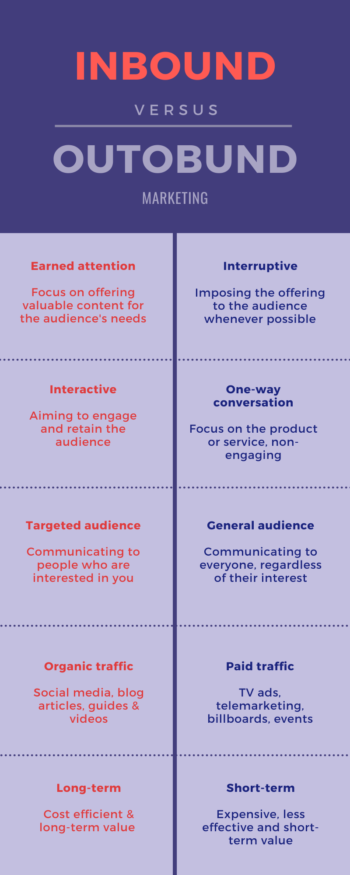By and large, people don’t like to be sold to. They want to be part of the process for sure, but on their terms. That means that in the first instance they’re only looking for information and with the internet, there’s information everywhere. You can not only find what you’re looking for but compare it to similar products from different providers, find user reviews and base your decision on price, color, size and so on. The options are seemingly endless. So, the question is, how do I stand out from the crowd and gain a competitive advantage?
Traditional marketing
Traditional marketing focuses on the biggest mediums such as television, radio, print and outdoor to sell their products and services. In theory, this makes sense. Surely more exposure means more sales, doesn’t it? Not really. The biggest problem of this scattergun approach is that there is virtually no targeting at all, which means most of the time you miss your mark. In fact, it was most probably this which made John Wanamaker the US merchant say, “Half of the money I spend on advertising is wasted, the trouble is I don’t know which half.”
The general population also finds mass-market advertising intrusive which is why some apps offer you the chance to experience their product ‘ad-free’ and why the most popular button on YouTube is ‘Skip ads’. Well, now we know the audience isn’t listening and the expense is astronomical, so where should marketers be focusing their efforts to ensure their product gets the public’s attention? Here is where inbound marketing comes into play.
From stealing your target audience’s attention to earning it
An increasing part of the customer journey takes place online and a prospect has already looked for a solution for their problem and taken many steps in the decision-making process before contacting the service providers. It is therefore important that the prospect can find you already during that process. Inbound marketing focuses on content – interesting and engaging pieces that provide answers, solve problems, and genuine interest the reader. In the inbound marketing method, we put ourselves in a position to be found by the customer when looking for a solution for their existing problem.
So, the trick here is to make sure that your content is findable at the right time at the right place. The aim is to be seen as a trusted advisor and source of information. When your organization is there to offer a solution for their pain points, the prospect is more likely to buy from you. Once you have offered this valuable content for them, you get permission to approach them in the future as well. This, of course, also places a demand on the content provided and its quality. By solving your target audience’s problems with good content, you increase trust and are more likely to get new customers from them. Quality content also rewards you by improving your search engine visibility, leading more and more potential customers to you.
Why should you invest in blog content?
Let’s first consider what is effective marketing? Effective marketing will build relationships and trust between you and the customer. Blog content is an extremely good tool for doing this and will bring valuable content to your customers even before they’ve got an initial contact with you. With blog content, you are able to answer customer questions and convince them about your suitability even before they ever approach you in person. As long as your content answers a specific need, you will attract new visitors to your website and if you have a high converting website, these new visitors will turn into new customers.
Managing the buyer journey with inbound marketing
Whereas with outbound marketing the goal is only to catch your audience’s attention, but the rest of the buyer journey is not really addressed. With inbound marketing, you are able to influence a bigger part of the decision-making process and steer the buyer forward on the buying path. Web visitors can be guided forward on a buying path through blogs, emails, newsletters, and other elements of inbound marketing. At its best, a well-planned content plan is effective in each decision-making step and gives you more marketing power.
Cost-efficient method of growing your business
Compared to outbound marketing that involves a temporary or short-term campaign, inbound marketing is a continual process of content creation. It requires commitment and resources to build your brand online and create content. However, this does not mean that inbound marketing is more expensive or less effective than traditional outbound marketing. In fact, it is quite the opposite. HubSpot surveyed cost per lead when using inbound marketing, and the results show that the costs are about 60% lower than the cost per lead for outbound marketing. With inbound marketing, you are driving organic traffic to your website, and having lots of good content will keep visitors coming back and improve your search ranking. Consequently, your audience will grow exponentially, your company’s image as experts in their field will be increased and there will be greater awareness among potential buyers.
Related article: Why you should combine inbound marketing and outbound sales?
Interested in discussing how inbound marketing activities could work for your organization? Leave us a message. We’d be keen to schedule a call.


